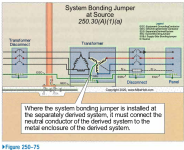I have a single-phase two-wire online (double conversion) UPS, with 120-V input and 120-V output.
The UPS has its input neutral isolated from its output neutral internally. It does not contain a maintenance bypass switch nor a static bypass switch.
The input of the UPS is an assembled flexible cord with a L15-30P plug (with a ground prong).
The output of the UPS is not a feeder, it does not contain a main breaker. It simply has multiple 5-20R receptacles, each with a ground slot, to which PDUs (power strips for telecom) are connected, to which IT equipment is connected (switches, routers, servers).
Additionally, the chassis of the UPS has a ground screw, internally tied to the input and output grounds, and the chassis, of course.
The UPS is from the manufacturer CDP (Chicago Digital Power), model UPO11-3RT (3kVA, rack-mount).

The UPS classifies as a separately derived AC system, correct? If so, how should the bonding of the output neutral be done? Would opening the UPS to internally install a jumper between the output neutral and its chassis (provided the user manual allows it) comply with sec. 250.30(A)(1) and 250.20 of 2020 NEC, correct?
Finally, how should the output neutral of the UPS be grounded? Technically speaking, since I'll bond the output neutral to the chassis, and the chassis is connected (through the EGC of the UPS' flexible cord) to the main panelboard ground bar, which is already grounded, then the output neutral is already grounded (this of course would apply to any SDS). But I think this would imply using an EGC as a GEC, which is not allowed per 250.121(A), correct? If so, then how should it be done? Would it be acceptable to install a wire between the chassis ground terminal of the UPS and the RGB (rack ground busbar) of the server rack, which is then connected to the MGB (master ground busbar) of the room, which is then connected to a GES (grounding electrode system)? Because I'll actually have two UPSes per rack, and various racks (each with two UPSes).
If you need diagrams to understand my ideas please say so.
The UPS has its input neutral isolated from its output neutral internally. It does not contain a maintenance bypass switch nor a static bypass switch.
The input of the UPS is an assembled flexible cord with a L15-30P plug (with a ground prong).
The output of the UPS is not a feeder, it does not contain a main breaker. It simply has multiple 5-20R receptacles, each with a ground slot, to which PDUs (power strips for telecom) are connected, to which IT equipment is connected (switches, routers, servers).
Additionally, the chassis of the UPS has a ground screw, internally tied to the input and output grounds, and the chassis, of course.
The UPS is from the manufacturer CDP (Chicago Digital Power), model UPO11-3RT (3kVA, rack-mount).

The UPS classifies as a separately derived AC system, correct? If so, how should the bonding of the output neutral be done? Would opening the UPS to internally install a jumper between the output neutral and its chassis (provided the user manual allows it) comply with sec. 250.30(A)(1) and 250.20 of 2020 NEC, correct?
Finally, how should the output neutral of the UPS be grounded? Technically speaking, since I'll bond the output neutral to the chassis, and the chassis is connected (through the EGC of the UPS' flexible cord) to the main panelboard ground bar, which is already grounded, then the output neutral is already grounded (this of course would apply to any SDS). But I think this would imply using an EGC as a GEC, which is not allowed per 250.121(A), correct? If so, then how should it be done? Would it be acceptable to install a wire between the chassis ground terminal of the UPS and the RGB (rack ground busbar) of the server rack, which is then connected to the MGB (master ground busbar) of the room, which is then connected to a GES (grounding electrode system)? Because I'll actually have two UPSes per rack, and various racks (each with two UPSes).
If you need diagrams to understand my ideas please say so.


